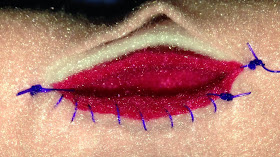The
short answer is: maybe not! Cystotomy to remove urinary calculi is one of the
most common surgeries performed in small animal private practice. It is a surgical
procedure that is considered to be straightforward and easily performed.
However, removal of all calculi can be challenging. One study found that in 20%
of dogs cystotomy failed to remove all calculi.(1)
Key Point: Recurrence of calculi after cystotomy may be due to calculi left behind rather than formation of new stones.
Key Point: Recurrence of calculi after cystotomy may be due to calculi left behind rather than formation of new stones.
During
cystotomy, small stones in the urinary bladder tend to gravitate into the neck
of the bladder and the proximal urethra. These will need to be removed by
flushing them into the bladder using a urethral catheter. This retrograde
flushing is a critical part of the surgery to remove all calculi present
and leave none behind.
Preoperative preparation
After
inducing general anesthesia, place the dog on its back and pass a lubricated sterile
catheter into the urethra. If possible, empty the urinary bladder using the
catheter, or perform cystocentesis to empty the bladder to reduce intraluminal
bladder and urethral pressure. Flush the urethra with sterile saline to flush
stones retrograde into the bladder. Sterile KY jelly can be mixed with the
saline to lubricate the calculi and facilitate retrograde flushing. If
necessary, have an assistant compress the urethra with a finger in the rectum
while initially injecting saline in the catheter to help generate pressure in
the urethra causing it to dilate. Release
the urethral pressure during flushing to allow stones to pass through the
urethral lumen and enter the bladder. Leave the catheter in while prepping the
abdomen for surgery to prevent stones from migrating back into the urethra.
Surgical Technique
Place
the dog in dorsal recumbency and drape the penis in the operative field. This
will allow passage of a sterile catheter during surgery and retrograde flushing
after the cystotomy has been performed.
The
urinary bladder is approached through the ventral abdominal midline. An alternative in the male dog is the
paramedian abdominal approach. (See: https://drstephenbirchard.blogspot.com/2014/07/cryptorchidism-in-dogs-5-ways-to-make.html) The author frequently uses this approach, especially if
exploratory of the entire abdomen is not necessary. The paramedian approach avoids incising around the prepuce and preserves preputial vessels and muscle.
After
opening the abdomen, identify and exteriorize the urinary bladder and place
stay sutures on the ventral aspect of the bladder. Isolate the bladder with
moistened laparotomy sponges to prevent urine spillage into the abdominal
cavity. Make an incision in a
relatively avascular area of the ventral bladder between the stay sutures.
The
entire bladder lumen is examined.
Excise a small sample of bladder mucosa and submit for bacterial culture.
Remove calculi using a bladder spoon. (Fig. 1)
 |
| Fig. 1: Remove calculi with a bladder spoon. |
 |
| Fig. 2: A catheter in the penile urethra is used to retrograde flush calculi into the open bladder during cystotomy. |
Flush with sterile saline through the urethral catheter until no further stones are recovered.(Fig. 2) Multiple flushes are usually required to remove all stones, especially small ones. Be patient and thorough to be sure all calculi are removed. Also flush the bladder lumen to remove stones adhered to the mucosa.
Bladder Closure
Although the traditional urinary bladder
closure is a double inverting layer (Fig. 3), a single layer, either simple interrupted or
continuous, is preferred especially in bladders that are very thickened (Fig. 4a).
 |
| Fig. 3: Traditional 2 layer closure of the cystotomy incision. (Cushing and Lembert pattern) |
 |
| Fig. 4a: Simple interrupted closure of a cystotomy incision. Simple continuous pattern can also be used. |
With single layer bladder closure, take full thickness bites of
the bladder wall but grab only a small amount of the mucosa. Absorbable sutures are used (3-0
or 4-0 Monocryl). Leak test the bladder incision by injecting sterile saline
into the bladder lumen.(Fig. 4b) Place additional sutures if leaks are found.
Lavage the
bladder and surrounding area of the abdomen and perform routine abdominal
closure.
Prior
to recovery from anesthesia, obtain abdominal radiographs to confirm that all
stones have been removed. (Figs. 5a,b)
 |
| Fig. 5a: Preoperative radiographs of a dog showing radiopaque calculi in the urinary bladder. |
 |
| Fig. 5b: Immediate postoperative radiographs of same dog in Fig. 5a showing removal of all calculi. |
If additional stones are seen, take the
animal back to surgery to remove them.
Postoperative Care
Routine
supportive care is administered postoperatively, such as intravenous fluids,
analgesics, and antibiotics if necessary. Indwelling urethral catheters can be
used if necessary because of urethral damage, bladder rupture, or if the
bladder needs to remain decompressed for other reasons.
Long-term
antibiotic therapy is prescribed if the urine or mucosal culture was positive.
Always submit calculi for analysis. Further recommendations such as dietary
therapy and other measures are made to prevent recurrence of stones.
References
1. David C. Grant;
Tisha A. M. Harper; Stephen R. Were. Frequency
of incomplete urolith removal, complications, and diagnostic imaging following cystotomy
for removal of uroliths from the lower urinary tract in dogs: 128 cases (1994–2006) J Am Vet Med Assoc
2010;236:763–766











